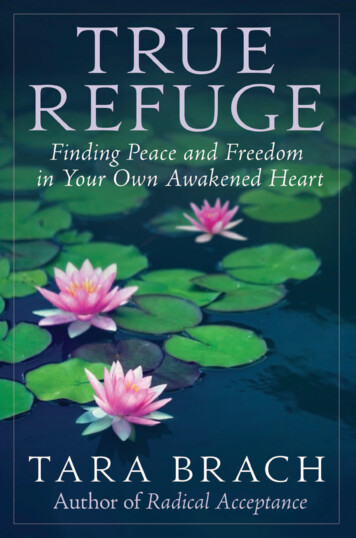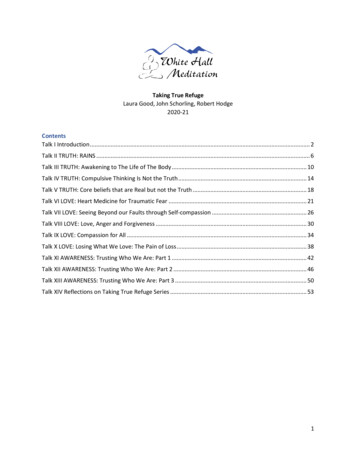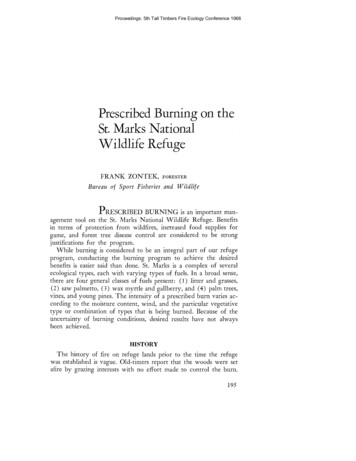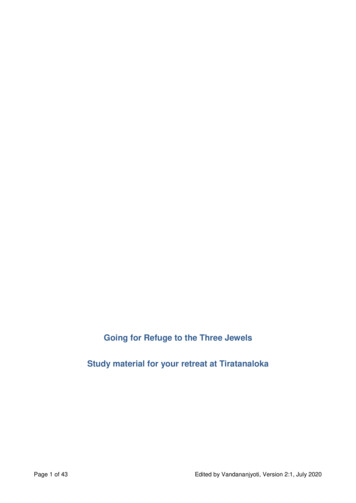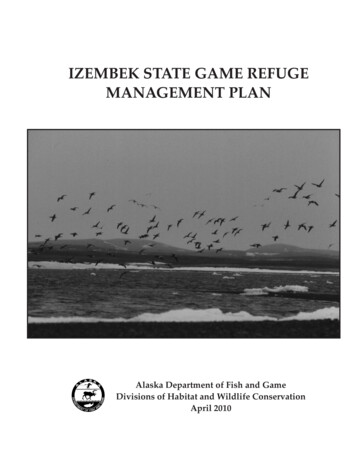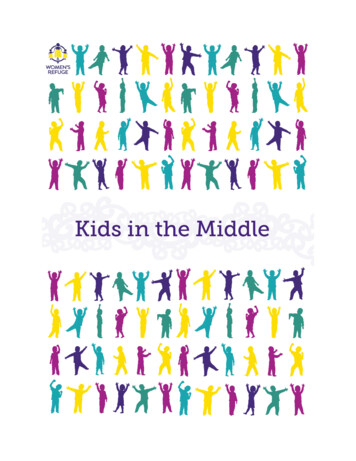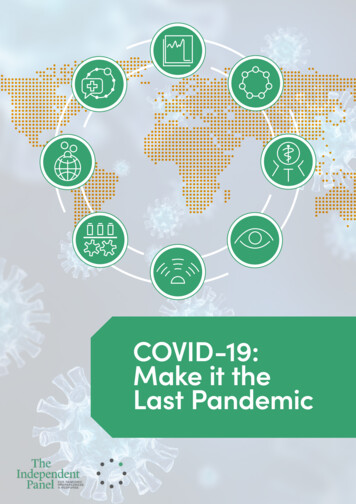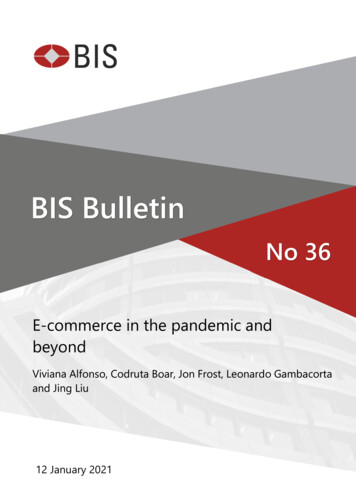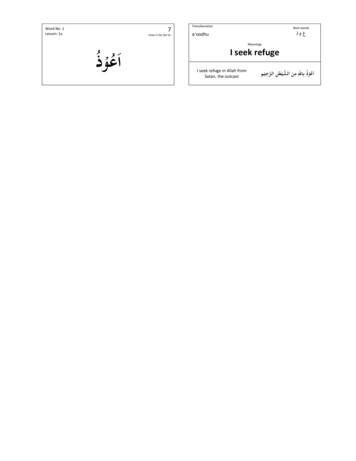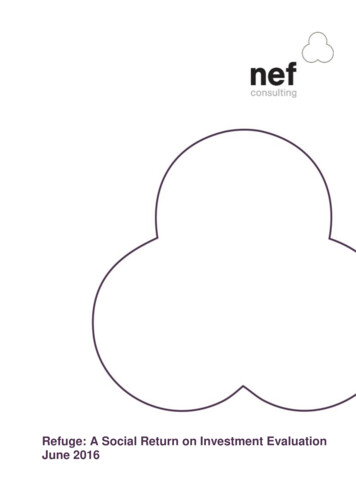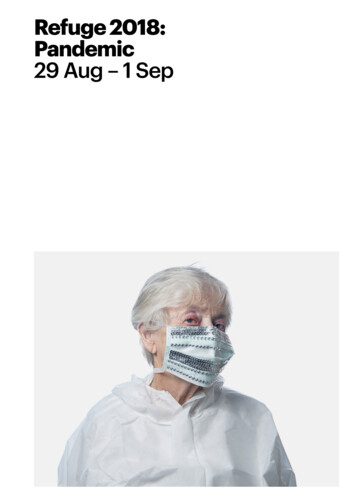
Transcription
Refuge 2018:Pandemic29 Aug – 1 Sep
Womin jeka booeegigat wilam,Welcome moongmoonggak.Berring-takal woke-kirebangal-ith djerringbulok palreetith.Wanganyinu nuringian biik wanganyinungargkan-narranta biik.Ganbu Kulin nuringianith biik baambuth.Onemdaal kyinandoo-djak djerring, yiookgen,Yurlendj-dji, booje, nganggak nuringianeit.Loggegerrebi ba nuringian-djak.— Ngoon GodjinWelcome to Art House, Welcome to Refuge.Our Climate is changing due to human activity.When we care for Country we understand Country.First People have been caring for Country since thebeginning of time.Our most precious resource is each other, a plan,what skills do you have, come inside listen carefully.Take part and take care.— Thank YouFrom Wurundjeri Council, Aunty Gail SmithArts House respectfully acknowledges the TraditionalOwners of the land, the Boon Wurrung andWoiwurrung (Wurundjeri) peoples of the Kulin Nationand pays respect to their Elders, past and present.For the Kulin Nation, Melbourne has always been animportant meeting place for events of social,educational, sporting and cultural significance. Todaywe are proud to say that Melbourne is a significantgathering place for all Aboriginal and TorresStrait Islander peoples.2 Welcome2 Acknowledgementof Country4 About Refuge5 Refuge 2018:Pandemic6 Breath of theMindyeAs told by UncleLarry Walsh ofTaungurung9 Hypothetical:What If?Michele Lee10 In Case Of Kate Sulan,with students fromSt Joseph’s FlexibleLearning Centre12 Ruth Crow CornerLorna Hannan13 ApitherapyQuarantineJen Rae,Fair Share Fare14 TiddaflyEllen van Neerven15 We ContainMultitudesMadeleine Flynn &Tim Humphrey,with Live UmbrellaFinland16 Supper Club:SanatoriumLizzy Sampson &Asha Bee Abraham17 Isolate andContain! Mappingthe PandemicLee Shang Lunwith PlayReactive17 OutbreakLee Shang Lunwith PlayReactive18 Practising for aDisasterwith AustralianRed Cross20 Refuge Schedule22 ContagiousConversations23 Biographies24 Support25 Thank You
RefugeRefuge 2018:PandemicWed 29 Aug –Sat 1 SepRefuge explores therole of artists and culturalinstitutions in timesof climate catastrophe.“Climate change isaltering theenvironment in waysthat increase thepotential for viruses.”— Maryn McKenna,New York Times2018 Artists & projects include— Isolate and Contain! Mapping the PandemicLee Shang Lun with PlayReactive— Hypothetical: What If?Michele Lee— Supper Club: SanatoriumLizzy Sampson & Asha Bee Abraham— Apitherapy QuarantineJen Rae, Fair Share Fare— In Case of Kate Sulan, with students from St Joseph’s FlexibleLearning Centre— OutbreakLee Shang Lun with PlayReactive— Ruth Crow CornerLorna Hannan— TiddaflyEllen van Neerven— We Contain MultitudesMadeleine Flynn & Tim Humphrey, withLive Umbrella Finland— Practising for a Disasterwith Australian Red CrossExtreme heat, rising sea levels, forced migration,increased spread of diseases, social unrest, extinctions– climate catastrophe is here. Refuge is now in yearthree of a five-year project that examines potentialclimate-related disasters and traces how we mightcollectively respond.Each year until 2020, we’re bringing togetheremergency management, artists and local andregional communities to prepare Arts House;as a relief centre, as a place of communityconnections, as a site for creative preparednessand artworks that help us imagine our collectivefutures, through climate disasters.In 2017, we envisaged the increasing possibility offive consecutive days over 40 C; a heatwaveacross Victoria.Refuge is about social and community resilienceand valuing an artistic approach to complex issuesand propels a growing cohort of artists into leadingedge innovators – as they make work under theconditions of climate change. This project is key toArts House’s commitment to explore responses toclimate justice, engage deeply with local communitiesand present innovative and experimental art.How can we build resilience, connect and respond ininclusive, ethical and humane ways? In times likethese, what’s our most precious resource? Thekindness of strangers? Each other? A plan? What skillsdo we have?In 2016, we imagined a local flood and transformedthe North Melbourne Town Hall into a relief centrefor 24-hours.Come participate in Refuge and get creative aboutreadiness.In 2018, we examine a pandemic event and whathappens to the social and environmental fabric of acity through the risk of contagion or quarantine.4Refuge 2018: Pandemic explores the health impacts ofclimate change: epidemics, grief, stigma, and anxietiesinvoked by the language of disease. In nightmares,and in histories past and present – including those ofcolonisation and genocide – pandemics have broughtunspeakable disaster on communities. Our bodies, andthose of our loved ones, are our most valuedpossessions. Pandemics and epidemics challenge usto understand our corporeality, fears and taboos; andteach us the necessity of ritual.Refuge’s offering is radical and full of compassion.How can we write ourselves into some of the scariestscenarios imaginable? We owe this thinking to ourcommunities, and we need to find as many ways aspossible to prepare. Over four busy days that includepublic forums, games, conversations and artisticworks, join us at Refuge 2018: Pandemic at the NorthMelbourne Town Hall for real information and realscience, as we get real creative in our readiness forwhat the future may hold.5
Breath of the MindyeAs told by Uncle LarryWalsh of TaungurungImage: Will Box“I’m from Taungurung people butthis is a story of all Kulin people.size and distance. When he stretchesto the right distance and arrives at theright land, he breathes out an illness asa punishment that can harm or killKulin people. You might not haveknown what you were being punishedfor, but it was a common belief thatgreat illness that affected everybodywas done by the Breath of the Mindye.The Wurundjeri Woiworung ofMelbourne, the Bunurong ofMelbourne, the Jajowrong Jarra of theBendigo / Castlemaine area to Ballaratand the Wathawurrung.We all believe that our creator Bundjil,who sometimes appears as a man andcan also turn into an eagle, had acreature which we call the Mindye, asnake who lives in barren country thatis very rocky and quartzy.Bundjil’s laws/lores were everythingfrom how you treat your children, yourvisitors, old people to your land, toobserving that fact that you were fromdifferent skin groupings and thereforethere are certain animals you cannoteat or animals that you must hunt oreat in a certain way. Back then, a lot ofAboriginal women wouldn’t eat thebreast of certain animals because theybreastfed their children and believed itwould poison their breastmilk.Every time Bundjil feels that a mobneeds punishment for not followingBundjil’s law/ lore, he summons theMindye. The Mindye then ties himselfto the highest tree in his land, andstretches out so that he increases in6Whether they were true or not, wecan’t judge, but the rules were put inplace for a reason.of the people who need to bepunished, there is an airborneinfection that kills like a pandemicdoes.It is thought there was only one personwho could stop the Mindye. A mannamed Moonee Brum-Brum who wasthe guardian of that area and, for wantof a better word, the doctor of thearea. So you’d go and see MooneeBrum-Brum if you were crook and he’dsort you out. There isn’t much knownabout him now, whether he was amythical man or a real person we don’tknow, but Bundjil did have people whocould intercede on his behalf so hemight have been one of them.As far as we see it, if we had modernterms back then, yeah, we had apandemic. But for us it was the breathof the Mindye that was death andillness as punishment for breaking alaw/lore.”In some ways, it is similar to having apandemic because a lot of illnessesare airborne. So when the Mindyebreathes air and illness in the direction7
Theatrical event7pm, Thurs 30 Aug90 minsArts House, Main HallLead Artist, Concept and Text:Michele LeeDramaturg and collaborating artist:Jessica BellamyPerformer and collaborating artist:Jem LaiSound Designer:Russell GoldsmithVoice-over Artist:Josh PriceHypothetical:What if?Michele LeeWhat could happen if a rapidly spreadingcontagion threatened Melbourne? Join usas we hear how those who take control in acrisis might grapple with the spread of adangerous infectious disease. In this highlyperformative and humorous iteration ofthe panel discussion format, our unlikelyheroine/assistant/presenter will navigatethe key moments of a terrifying Melbourneoutbreak with an expert panel.I got lucky in the lottery of life.somewhat fictional; it’s a sideways sort of recipe forwhat to do and feel and think in the likely event of thenext viral outbreak.I was born in Canberra. I never broke a bone growingup; I never sprained a muscle. I went to my first funeralat 19. And that wasn’t for any close family.I’m drawn to characters, stories, people and ourcontradictory behaviours. I put a character into this.She’s young. She’s running this discussion. She doesn’thave all the answers. I don’t. The expert panel don’teither. We’re going to figure this out together.Audience interaction is welcome. You are necessary.I get terrible hay fever, sometimes my period makesme achy, and maybe once a year I get a cold (or maybeit’s a mild flu). If I travel, I might get bedbugs and foodpoisoning. So, yep, that is my short list of healthconcerns. I’m healthy.— Michele LeeThis is a panel discussion for a fake epidemic withreal-life experts. This fictional epidemic focusses onthe sort of disease outbreak that is monstrous; I haven’tpersonally experienced it although it feels all too real.In part we have movies and stories to thank for that,disaster narratives that are firmly embedded in ourpopular imagination.Panel:Dr Julian Druce, Head of Victorian Infectious Diseases ReferenceLaboratory (VIDRL) at the Doherty Institute for Infection & ImmunityJustin Dunlop, Acting Director Emergency Management forAmbulance Victoria and State Health Commander.Dr Cassidy Nelson, Principal Public Health Medical Officer,Communicable Disease, Department of Health and Human ServicesDr Ines Rio, Chairperson NW Melbourne Primary Health NetworkSteve Cameron, Coordinator of Community-based emergencymanagement at Emergency Management VictoriaYou’ll get a discussion and performance; it’s going tobe funny and weird and anxious and somewhat factual,89
Art Exhibition30 Aug – 1 Sep1pm – 7pm, Thurs 30 Aug1pm – 7pm, Fri 31 Aug11am – 4pm, Sat 1 SepLead Artist:Kate SulanExhibition Design:Lizzy SampsonSt Joseph’s Flexible LearningCentre:Mairead Hannan, Associate Headof Campus and Justin Olmstead,Art TeacherIn Case Of. has been supportedby Creative Learning Partnerships –a Victorian government initiativeIn Case Of Kate Sulan,with students fromSt Joseph’s FlexibleLearning CentreGuest Artists: Emily Barrie,Pia Johnson, Steph OharaAn exhibition of personal emotionalpreparedness kits that have been made inconversation with students from St Joseph’sFlexible Learning Centre. These reparednesskits emphasise the preparedness and staminathat vulnerable young people need on adaily level and the societal planning we needfor uncertain futures and scenarios.Image by Lizzy Sampson. Environment by students with Kate Sulan & Emily BarrieImage by Lizzy Sampson. Environment by students with Kate Sulan & Emily BarrieIn Case Of has enabled artist in residence Kate Sulanand our art teacher Justin Olmstead to create a safecontext in which young people could explore tools andideas for feeling safe and for wellbeing. Students havethrived within the long-term structure of the project,gaining confidence in their art-making practice witheach new activity and showing increased willingnessto explore their emotional needs during regular livelydiscussions.Flexi schools are messy schools. Messy from thegraffiti that graces our walls, to the goo that we makefor science experiments and the paint drips that colourthe art room floor. If school was a colouring-in book,St Joseph’s FLC would be outside the lines every time.When young people join a flexi, learning might lookdifferent to anything they’ve experienced before.Learning can happen when you play the pianooutdoors, do tie-dye, make stencil art to decorate ourbasketball court, go camping or snorkelling.This exhibition is an expression of some of thethings that would be in our collective kit. Togetherour exploration has covered comfort objects, wordsof advice, environments and textures that soothe,qualities and traits we possess, inspiring mentorsand friends, sounds and music, comfort food and therole of imagination in times of crisis. We have playedwith different mediums and art forms and discussedboth real and imagined disasters in our lives.In the case of an emergency, Red Cross and otherEmergency Services advise us to have a preparednesskit at the ready – a ‘grab and go’ bag. Their list is fullof practical items, documentation, first-aid supplies,emergency phone numbers and the like.In Case Of asks what else preparedness might lookslike. What other resources do we have internally andexternally to keep us afloat? What is the place of hope,of grit, of imagination and of humour in times of crisis?The lived experience of students who find themselvesat St Joseph’s Flexible Learning Centre mean theyhave much to contribute to a conversation aboutresilience. We have learnt so much from theirperspectives and wisdom.In Case Of is the creation of an alternativepreparedness kit. Working with the students ofSt Joseph’s Flexible Learning Centre, we haveimagined a different type of ‘grab and go bag’, onethat provides emotional support and helps us toaccess our best selves.— Kate Sulan and Lizzy Sampson, Artists10The wide variety of art-making activities offered hasalso catered to the diversity of talents within each classgroup, and provided a multitude of opportunities forstudents of all learning styles to express their personalflair and feel connected to the project.Sometimes even our staff are caught by surprise.Sometimes staff are greeted in the morning by anunexpected sight; a young person waiting on theschool steps or asleep in the under croft. Sometimesthis is because the young person has had a roughnight, other times because they are keen to be the firstin to breakfast or the gym; the first to re-enrol, record asong or arrive first for an excursion.We are truly grateful to Kate and to the Arts Houseteam for their enthusiasm, professionalism andcreativity in working with vulnerable young peopleat our school and we hope the exhibition at Refugegives insight into the wonderful variety of ways thatour young people learn and express emotional safety,each contributing to the glorious mess that is our flexischool community.Funded by Creative Victoria, In Case Of has givenour young people the opportunity to learn throughcreativity. They created emotional wellbeing kits, toconsider personal and community safety throughan artistic lens for today and for the future. Livedexperiences of sleeping rough or seeking asylum havemeant that our young people have a lot to offer inarticulating emotional needs and keeping safe.— Justin Olmstead and Mairead Hannan, Teachers atSt Joseph’s Flexible Learning Centre11
Facilitated discussion30 Aug – 1 Sep1pm – 6pm, Thurs 30 Aug1pm – 6pm, Fri 31 Aug11am – 4pm, Sat 1 SepLead Artist:Lorna HannanRuth Crow CornerLorna HannanInteractive live art30 Aug – 1 Sep1pm – 7pm, Thurs 30 Aug1pm – 7pm, Fri 31 Aug11am – 4pm, Sat 1 SepWarnings: Allergy for nuts and beeor bee related productsLead Artist: Jen RaeDesign: Indie LadanPhotography: Emma ByrnesContributing Artists: Clare Callow,Fiona Hillary, Lorna HannanSound Engineering:Marco Cher-GibardBee-keepers: Rooftop HoneyChamber Design: A-GradeHydroponicsContributing therapists: Dave Butt,Kelly Gillespie, Aviva Reed, LindaTegg and Ilian Tor HellanderApitherapyQuarantineJen Rae,Fair Share FareMeet Lorna Hannan, resident of NorthMelbourne for over 50 years. Lorna and aband of locals are coming together to getto know neighbours and hear their stories,learn from experts and make great thingshappen. Pop in for a cuppa.Honey bees are dying worldwide as theresult of a human-caused pandemic.In this immersive-spa-meets-science-labmeets nature-reserve to explore ideas ofparanoia, risk, health and biosecurity.API THERA PYapis therapia [bees] [to cure] Latin translation‘bee therapy’Bees and other pollinators are responsible forpollinating over 80% of all flowering plants, includingup to 70% of our top human food crops. A massdie-off of bees could trigger a chain reaction resultingin devastating impacts to global food production.We lose bees, we starve.QUAR AN TINEquaranta giorni [forty days] ItalianThe Apitherapy Quarantine explores our symbioticrelationship to bees, via an immersive spa-meetsscience-lab-meets-urbanagriculture environmentin an ongoing Fair Share Fare collaboration withArts House’s resident colony of bees.You are separated from the group or you are thegroup. What treatment is in store?Over a cuppa here at Ruth Crow Corner, we willinvestigate how we as a community can face up to thechallenges of daily life, preparing us for the biggerstresses as they arise.40 years ago, Ruth Crow, a resident of NorthMelbourne showed us that if you sit down and talkover a cuppa, “great things happen”.We want to follow in the tradition of Ruth Crow andalso maintain conversation as an art form. Within thatart form, storytelling is one of the most potent ways ofspreading ideas.Conversation will show us how we need to live anyway,every day, not just in times of stress.Come and join us, we’ll give you a big welcome.Over the past two years, we have discussed andshared ideas on how to face up to floods andheatwaves. Now we are looking pandemic in the eyeand searching for the answers we will need.— Lorna HannanPlease note: The Ruth Crow Corner is also host to a series of ContagiousConversations with artists to experts. See the schedule in this program formore information.So here is your opportunity to have some serious fun,to find out more for yourself, to join the conversationand the storytelling, to make your own protectivemasks and play games.12The Apitherapy Quarantine (AQ) was created inresponse to what seemingly is an increase in‘quarantine’ or ‘isolationist’ thinking in today’s sociopolitical climate. By focusing on the big, sometimes‘imagined’ or ‘fake’ threats, we limit our ability to seewhat may be greater dangers on our doorstep.Apitherapy is a branch of alternative medicine thatuses bees and bee products to treat specific ailments.The AQ therapists will offer isolated treatments forwhat may ail you in mind, body, spirit and/orcommunity.The AQ looks at our relationship to bees, a less visiblethreat to human survival. Viruses don’t just targethumans. They can infect all forms of life from bacteriato bananas, soil to chickens, and also honeybees.A human-caused pandemic is killing billions of insectsand bees worldwide.You may want to rush out. You may be put to work.You may never want to leave.— Jen RaePlease note: The AQ asks you to leave your possessions, fears, sins, secretsand desires before entering. This gesture is based on a reinterpretation of amedieval tradition called ‘telling the bees’ – an observance where a bee speakerwould share important community news with the bee colony. Lorna Hannan isthe resident bee speaker at Arts House, North Melbourne Town Hall.A lethal combination of neonicotinoid pesticide use,the varroa mite, deformed wing virus, trade andhabitat loss are all contributing to a fast and alarmingdecline in bee populations.13
Audio installation30 Aug –1 Sep1pm – 7pm, Thurs 30 Aug1pm – 7pm, Fri 31 Aug11am – 4pm, Sat 1 SepLead Artist:Ellen van NeervenTiddaflyEllen van NeervenAudio led work30 Aug – 1 Sep1pm – 7pm, Thurs 30 Aug1pm – 7pm, Fri 31 Aug11am – 4pm, Sat 1 SepLead Artists: Madeleine Flynn andTim Humphrey, Johanna TuukanenSound and Text: Madeleine Flynnand Tim HumphreyText and Performance:Johanna TuukanenStill images: Pekka MäkinenMoving images: Sam McGilpSoftware: Mick Byrne WeMakeAppsProducer: Maija EränenWe Contain MultitudesMadeleine Flynnand Tim Humphrey,Johanna Tuukkanen(Live Umbrella, Finland)An audio installation about identity, fearand survival, narrating Indigenous pasts/presents/futures through spoken wordand sound. Engaging with disrememberedhistory and erasures, Tiddafly repositions andreclaims space. This work asks: what trulycomforts us when we are sick?We Contain Multitudes is an audio exitpoll that takes place in a bathroomand which asks the unreliable oracle ofcloudspace to mediate betweenremembrance and forgetting.Image: Pekka MäkinenCrowd diseases were first understood throughcolonialism. Dirty people brought dirty diseases neverseen before on this continent; Mob were much moreadvanced at looking after Country and their bodiesthan the ‘sophisticated people’. The Europeans hadn’tyet learnt how to separate sewage and drinking waterand lived with vermin.It is my cultural obligation to acknowledge that thiswork has been created on Boon Wurrung andWoiwurrung (Wurundjeri) land, and pay my respects toKulin Nation Elders past, present and emerging. I alsoacknowledge my ancestors, the Mununjali Yugambehpeople from South East Queensland.This is a work in progress created during a three-weeksound residency at Arts House. I thought it wasimportant to respond to this year’s Refuge theme:Pandemic by looking at our history which informs ourpresent and future.After the arrival of the First Fleet, Smallpox spreadfrom Sydney Cove, and devastated many parts of theEast Coast, including Victoria and the area now knownas Melbourne. Indigenous people had no immunity tothe disease, and it was quick and wideranging,reducing the population in some places by 90%. Theairborne virus was transmitted mostly through face-toface contact with an infected person but also throughcontaminated objects such as bedding or clothing.Tiddafly is an audio installation about identity, fear andsurvival, narrating Indigenous pasts/presents/futuresthrough spoken word and sound. Engaging withdisremembered history and erasures, this work asks:what truly comforts us when we are sick?Songs and warnings about the disease also travelled.Some Mob managed to escape its clutches. This is acelebration of their survivance, as well as in heavymemory to those who lost their lives.Blankets are universal. They represent warmth, careand family. First Nations groups around the countryhave their own names for furs, coverings and bedding.— Ellen van NeervenUnfortunately, since the arrival of the Europeans,blankets represent a fraught history in Australia. Theywere given as compensation for stolen land. Theywere used to control as part of the rations system.And they were part of the genocide project.Inflected through the category of existential risk thathas been coined as “the whimper” (2), we have sought totrack the inevitable slow fades of identity, thediminishing grievabilities that infect memory, andmemory sites, as our cruising masses of biota engagetheir epic and ultimately futile struggles to maintainthe body of humanity.In the development of We Contain Multitudes, wewere hosted as artists in residence at The Peter DohertyInstitute for Infection and Immunity, and with ourFinnish colleagues, Live Umbrella, at the MelbourneGeneral Cemetery. This has created some curiousalignments around disease and death. Like the tiltedchaos of the cemetery and its (literally) buried stories,alongside the unsung heroics involved in maintainingthe immunity of the herd inside a tightly-securedfacility. The inscriptive tradition of post-colonialcemeteries startled our Finnish colleagues, whosehabit is more restrained. A collection of these areincorporated as rejoinders for an agent-mediatedhand-washing experience.A moment for hand-wringing as much as handwashing?— Madeleine Flynn and Tim HumphreyNotes and Further Reading1. The term ‘tragedy of the Commons’ describes how individuals exploitshared resources for their own self-interest.2. In ‘Existential Risks: Analyzing Human Extinction Scenarios and RelatedHazards’ by Nick Bostrom (2002, www.nickbostrom.com) the “whimper”category is defined: “A posthuman civilization arises but evolves in adirection that leads gradually but irrevocably to either the completedisappearance of the things we value or to a state where those things arerealized to only a minuscule degree of what could have been achieved.”We Contain Multitudes reflects on the so-called‘tragedy of the Commons’ (1), a threatened principle fora humanity that extends even to our continuallytransferring and evolving micro-biome.Website links accessed online: August 2018.1415
Facilitated discussionover dinnerLead Artists:Lizzy Sampson &Asha Bee Abraham7pm, Fri 31 AugArts House, Main Hall120 minsCatering:Spade to BladeMock emergency exercise11am – 4pm, Sat 1 SepSupper Club:SanatoriumLizzy Sampson &Asha Bee AbrahamPracticing for aDisasterwith AustralianRed CrossAn interactive future-focused dinnerinvites you to meet and discuss thefuture of our survival with herbalists,epidemiologists, futurists, neo-peasantsand ethicists.Australian Red Cross, a key partner inRefuge, will be conducting a door-knockingand home-visit exercise with interestedcommunity members living in NorthMelbourne and West Melbourne, on Saturday1 September; to conduct mock well-beingchecks and to give specific information ofuse to local community members in theevent of an epidemic.Gather for collective convalescence and seek refugein the sanatorium, as we reflect on all that we havesurvived so far, and ready ourselves for what liesahead in this future-focused Refuge edition ofSupper Club. Sit and share a meal with an Indigenousfuturist, an epidemiologist, an HIV activist, an AIexpert, a neo-peasant, and an emergency responderto explore ethical survival, collective preparednessand potential worlds.We look towards the future while keeping an eyeon what we can learn from the past. We recognise thecolonial apocalypse of Australia’s past and present,and learn about what an indigenous-led future mightlook like. We think about the potential of technology,and discuss the ethics around Artificial Intelligence.We unpack what it is to live with a disease, how to formthe response team for an outbreak, and what ethicalsurvival might mean.We know the stories of individual survival, seenpreppers on the tv – the people with their bunkers,stocks of tinned beans and probably some weapons,ready to defend themselves and their families whenthe ‘sh*t hits the fan’. But we want to know whatpreparedness might look like on a collective levelwithout the blind panic.We do this over a shared meal, nourishing our bodieswith local, seasonal and organic food – ingesting theprebiotics and probiotics to build our resilience forthe work to come.— Lizzy Sampson & Asha Bee AbrahamHosts & Topics:Indigenous Futurism – Maddee Clark, University of MelbournePrevention & Preparedness – Kylie Carville, Doherty Institutefor Infection & ImmunityHerbs & Healing – Rasha Tayeh, Artist & HerbalistHIV & Vulnerability – Susan Paxton, Living PositivePandemic Response – Damien Moloney, Red CrossCollective Preparedness – Patrick Jones, Artist as FamilyJustice & Disease – Bridget Pratt, University of MelbourneAI & Outbreak Forecasting – Nic Geard, University of MelbourneContextualised within the Refuge Pandemic program,our Sanitorium is situated in the ‘Possible New Wave’,a post-pandemic phase where the threat of anotherwave of transmissions is possible.Over supper we unpack the implications of livingcollectively in a new world, where grief is indiscriminateand care for each other is paramount. How can wemaintain a sense of trust and community as we preparefor another pandemic? What do we do when culturalpractices and science don’t agree?16Australian Red Cross is thrilled to be a part of Refugefor the third year in a row. Through a unique projectthat brings together experts, artists and emergencyservice professionals we are able to challenge thetraditional way people think about relief and recoverycentres and bring a new lens forward.ARC volunteers will be delivering information aboutthe pandemic and also offering psycho social supportto the community, much in the way we would do inthe event of a real emergency. This will give us achance to practice our skills and see what we coulddo better in a real pandemic.Australian Red Cross will be at the North MelbourneTown Hall every day that Refuge is open where wewill be offering our services and assisting people toprepare for Emergencies. This year on September 1we will be conducting a mock exercise with membersof the public. Red Cross volunteers will be knockingon the doors of community members who haveoffered to be actors in a pandemic emergency.— Damien Moloney, Red Cross Emergency Services,Operations and Logistics Support OfficerPlease note this is an event run by the Australian Red Cross with the support ofArts House as part of the Refuge Project.17
Live interactive gameLead Artist:Lee Shang Lun6.30pm, Wed 29 AugArts House, Main Hall120 minsIsolate and Contain!Mappingthe PandemicLee Shang Lun withPlayReactiveLive interactive game30 Aug – 1 Sep12pm, 1pm, 2pm, 3pm, 4pm, 5pm,Thurs 30 Aug & Fri 31 Aug11am, 12pm, 1pm, 2pm, 3pm,Sat 1 Sep45 minsLead Artist: Lee Shang LunOutbreakLee Shang Lun withPlayReactiveA cross between immersive theatre,cooperative gaming and an escape room,Outbreak divides participants in half:One group wakes up in a room with norecollection of how they got there, the othersearches for a way to save the world.Roll the dice and experience a liveinteractive game to build an imaginaryvirus with advice from epidemiologistsand learn what happens in a pandemic,how they impact our communitiesand how we can survive.Both Isolate and Contain! Mapping the Pandemicand Outbreak aim to memorably communicate thescience, history, and politics of pandemics. Theywere developed through a residency at the PeterDoherty
Refuge is now in year three of a five-year project that examines potential climate-related disasters and traces how we might collectively respond. Refuge 2018: Pandemic explores the health impacts of climate change: epidemics, grief, stigma, and anxieties invoked by the language of disease. In nightmares,
